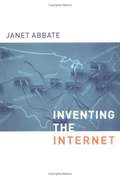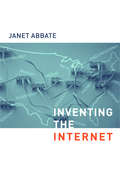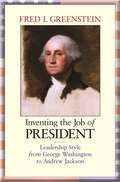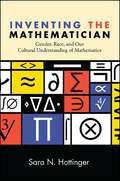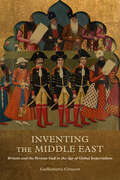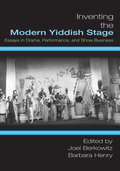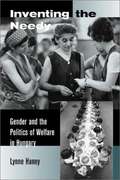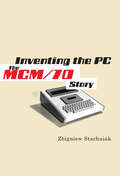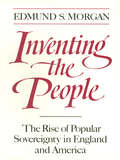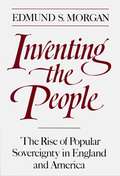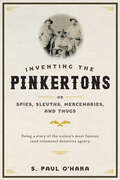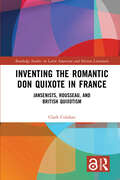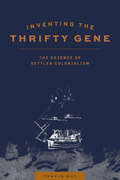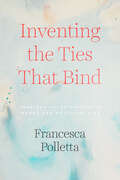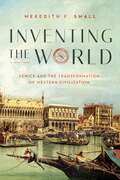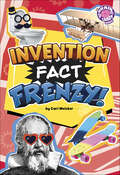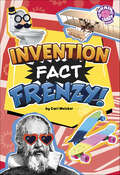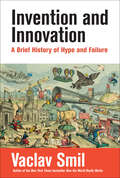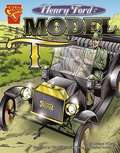- Table View
- List View
Inventing the Internet
by Janet AbbateSince the late 1960s the Internet has grown from a single experimental network serving a dozen sites in the United States to a network of networks linking millions of computers worldwide. In Inventing the Internet, Janet Abbate recounts the key players and technologies that allowed the Internet to develop; but her main focus is always on the social and cultural factors that influenced the Internets design and use. The story she unfolds is an often twisting tale of collaboration and conflict among a remarkable variety of players, including government and military agencies, computer scientists in academia and industry, graduate students, telecommunications companies, standards organizations, and network users. The story starts with the early networking breakthroughs formulated in Cold War think tanks and realized in the Defense Department's creation of the ARPANET. It ends with the emergence of the Internet and its rapid and seemingly chaotic growth. Abbate looks at how academic and military influences and attitudes shaped both networks; how the usual lines between producer and user of a technology were crossed with interesting and unique results; and how later users invented their own very successful applications, such as electronic mail and the World Wide Web. She concludes that such applications continue the trend of decentralized, user-driven development that has characterized the Internet's entire history and that the key to the Internet's success has been a commitment to flexibility and diversity, both in technical design and in organizational culture.
Inventing the Internet (Inside Technology)
by Janet AbbateJanet Abbate recounts the key players and technologies that allowed the Internet to develop; but her main focus is always on the social and cultural factors that influenced the Internet's design and use.Since the late 1960s the Internet has grown from a single experimental network serving a dozen sites in the United States to a network of networks linking millions of computers worldwide. In Inventing the Internet, Janet Abbate recounts the key players and technologies that allowed the Internet to develop; but her main focus is always on the social and cultural factors that influenced the Internets design and use. The story she unfolds is an often twisting tale of collaboration and conflict among a remarkable variety of players, including government and military agencies, computer scientists in academia and industry, graduate students, telecommunications companies, standards organizations, and network users.The story starts with the early networking breakthroughs formulated in Cold War think tanks and realized in the Defense Department's creation of the ARPANET. It ends with the emergence of the Internet and its rapid and seemingly chaotic growth. Abbate looks at how academic and military influences and attitudes shaped both networks; how the usual lines between producer and user of a technology were crossed with interesting and unique results; and how later users invented their own very successful applications, such as electronic mail and the World Wide Web. She concludes that such applications continue the trend of decentralized, user-driven development that has characterized the Internet's entire history and that the key to the Internet's success has been a commitment to flexibility and diversity, both in technical design and in organizational culture.
Inventing the It Girl: How Elinor Glyn Created The Modern Romance And Conquered Early Hollywood
by Hilary A. HallettA Publishers Weekly Summer Reads Selection The modern romance novel is elevated to a subject of serious study in this addictively readable biography of pioneering celebrity author Elinor Glyn. Unlike typical romances, which end with wedding bells, Elinor Glyn’s (1864–1943) story really began after her marriage up the social ladder and into the English gentry class in 1892. Born in the Channel Islands, Elinor Sutherland, like most Victorian women, aspired only to a good match. But when her husband, Clayton Glyn, gambled their fortune away, she turned to her pen and boldly challenged the era’s sexually straightjacketed literary code with her notorious succes de scandale, Three Weeks (1907). An intensely erotic tale about an unhappily married woman’s sexual education of her young lover, the novel got Glyn banished from high society but went on to sell millions, revealing a deep yearning for a fuller account of sexual passion than permitted by the British aristocracy or the Anglo-American literary establishment. In elegant prose, Hilary A. Hallett traces Glyn’s meteoric rise from a depressed society darling to a world-renowned celebrity author who consorted with world leaders from St. Petersburg to Cairo to New York. After reporting from the trenches during World War I, the author was lured by American movie producers from Paris to Los Angeles for her remarkable third act. Weaving together years of deep archival research, Hallett movingly conveys how Glyn, more than any other individual during the Roaring Twenties, crafted early Hollywood’s glamorous romantic aesthetic. She taught the screen’s greatest leading men to make love in ways that set audiences aflame, and coined the term “It Girl,” which turned actress Clara Bow into the symbol of the first sexual revolution. With Inventing the It Girl, Hallett has done nothing less than elevate the origins of the modern romance genre to a subject of serious study. In doing so, she has also reclaimed the enormous influence of one of Anglo-America’s most significant cultural tastemakers while revealing Glyn’s life to have been as sensational as any of the characters she created on the page or screen. The result is a groundbreaking portrait of a courageous icon of independence who encouraged future generations to chase their desires wherever they might lead.
Inventing the Job of President: Leadership Style from George Washington to Andrew Jackson
by Fred I. GreensteinHow the early presidents shaped America's highest officeFrom George Washington's decision to buy time for the new nation by signing the less-than-ideal Jay Treaty with Great Britain in 1795 to George W. Bush's order of a military intervention in Iraq in 2003, the matter of who is president of the United States is of the utmost importance. In this book, Fred Greenstein examines the leadership styles of the earliest presidents, men who served at a time when it was by no means certain that the American experiment in free government would succeed.In his groundbreaking book The Presidential Difference, Greenstein evaluated the personal strengths and weaknesses of the modern presidents since Franklin D. Roosevelt. Here, he takes us back to the very founding of the republic to apply the same yardsticks to the first seven presidents from Washington to Andrew Jackson, giving his no-nonsense assessment of the qualities that did and did not serve them well in office. For each president, Greenstein provides a concise history of his life and presidency, and evaluates him in the areas of public communication, organizational capacity, political skill, policy vision, cognitive style, and emotional intelligence. Washington, for example, used his organizational prowess—honed as a military commander and plantation owner—to lead an orderly administration. In contrast, John Adams was erudite but emotionally volatile, and his presidency was an organizational disaster.Inventing the Job of President explains how these early presidents and their successors shaped the American presidency we know today and helped the new republic prosper despite profound challenges at home and abroad.
Inventing the Mathematician: Gender, Race, and Our Cultural Understanding of Mathematics
by Sara N. HottingerWhere and how do we, as a culture, get our ideas about mathematics and about who can engage with mathematical knowledge? Sara N. Hottinger uses a cultural studies approach to address how our ideas about mathematics shape our individual and cultural relationship to the field. She considers four locations in which representations of mathematics contribute to our cultural understanding of mathematics: mathematics textbooks, the history of mathematics, portraits of mathematicians, and the field of ethnomathematics. Hottinger examines how these discourses shape mathematical subjectivity by limiting the way some groups—including women and people of color—are able to see themselves as practitioners of math. Inventing the Mathematician provides a blueprint for how to engage in a deconstructive project, revealing the limited and problematic nature of the normative construction of mathematical subjectivity.
Inventing the Middle East: Britain and the Persian Gulf in the Age of Global Imperialism
by Guillemette CrouzetThe “Middle East” has long been an indispensable and ubiquitous term in discussing world affairs, yet its history remains curiously underexplored. Few question the origin of the term or the boundaries of the region, commonly understood to have emerged in the twentieth century after World War I.Guillemette Crouzet offers a new account in Inventing the Middle East. The book traces the idea of the Middle East to a century-long British imperial zenith in the Indian subcontinent and its violent overspill into the Persian Gulf and its hinterlands. Encroachment into the Gulf region began under the expansionist East India Company. It was catalyzed by Napoleon’s invasion of Egypt and heightened by gunboat attacks conducted in the name of pacifying Arab “pirates.” Throughout the 1800s the British secured this crucial geopolitical arena, transforming it into both a crossroads of land and sea and a borderland guarding British India’s western flank. Establishing this informal imperial system involved a triangle of actors in London, the subcontinent, and the Gulf region itself. By the nineteenth century’s end, amid renewed waves of inter-imperial competition, this nexus of British interests and narratives in the Gulf region would occasion the appearance of a new name: the Middle East.Charting the spatial, political, and cultural emergence of the Middle East, Inventing the Middle East reveals the deep roots of the twentieth century’s geographic upheavals.
Inventing the Modern Yiddish Stage: Essays in Drama, Performance, and Show Business
by Barbara Henry Joel BerkowitzCollects leading scholars' insight on the plays, production, music, audiences, and political and aesthetic concerns of modern Yiddish theater.
Inventing the Needy: Gender and the Politics of Welfare in Hungary
by Lynne A. HaneyThis ambitious, fluid, and engaging book explains the political and social transformation of the Hungarian state from 1948 to the present. Haney reconceptualizes how we might understand the momentous changes of 1989, resisting the usual categories of the socialist past and the capitalist present.
Inventing the Opera House: Theater Architecture In Renaissance And Baroque Italy
by Eugene J. JohnsonIn this book, Eugene J. Johnson traces the invention of the opera house, a building type of world wide importance. <P><P>Italy laid the foundation theater buildings in the West, in architectural spaces invented for the commedia dell'arte in the sixteenth century, and theaters built to present the new art form of opera in the seventeenth. Rulers lavished enormous funds on these structures. Often they were among the most expensive artistic undertakings of a given prince. They were part of an upsurge of theatrical invention in the performing arts. At the same time, the productions that took place within the opera house could threaten the social order, to the point where rulers would raze them. Johnson reconstructs the history of the opera house by bringing together evidence from a variety of disciplines, including music, art, theatre, and politics. Writing in an engaging manner, he sets the history of the opera house within its broader early modern social context.<P> This is the only book, since the 1930s, to cover this subject, and the only English language one to ever be produced.<P> Sets the subject into a broad context of the arts, politics, and social history of the period.<P> The book aims to reach both specialists and the general reader, making it appealing to those who know the field well and those who do not care to plow through scholarly jargon.
Inventing the PC
by Zbigniew StachniakInventing the PC details the invention and design of the MCM/70 computer and the prolonged struggle to bring it to market. Zbigniew Stachniak offers an insider's view of events on the front lines of pioneering work on personal computers. He shows what information and options PC pioneers had, how well they understood what they were doing, and how that understanding - or lack thereof - shaped both their engineering ingenuity and the indecisiveness and over-reaching ambition that would ultimately turn a very promising venture into a missed opportunity. Providing comprehensive historical background and rich photographic documentation, Inventing the PC tells the story of a Canadian company on the cutting-edge of the information age.
Inventing the PC: The MCM/70 Story
by Zbigniew StachniakInventing the PC details the invention and design of the MCM/70 computer and the prolonged struggle to bring it to market. Zbigniew Stachniak offers an insider's view of events on the front lines of pioneering work on personal computers. He shows what information and options PC pioneers had, how well they understood what they were doing, and how that understanding - or lack thereof - shaped both their engineering ingenuity and the indecisiveness and over-reaching ambition that would ultimately turn a very promising venture into a missed opportunity. Providing comprehensive historical background and rich photographic documentation, Inventing the PC tells the story of a Canadian company on the cutting-edge of the information age.
Inventing the People: The Rise of Popular Sovereignty in England and America
by Edmund S. Morgan"The best explanation that I have seen for our distinctive combination of faith, hope and naiveté concerning the governmental process." --Michael Kamman, Washington Post This book makes the provocative case here that America has remained politically stable because the Founding Fathers invented the idea of the American people and used it to impose a government on the new nation. His landmark analysis shows how the notion of popular sovereignty--the unexpected offspring of an older, equally fictional notion, the "divine right of kings"--has worked in our history and remains a political force today.
Inventing the People: The Rise of Popular Sovereignty in England and America
by Edmund Sears MorganThis book makes the provocative case here that America has remained politically stable because the Founding Fathers invented the idea of the American people and used it to impose a government on the new nation. His landmark analysis shows how the notion of popular sovereignty the unexpected offspring of an older, equally fictional notion, the "divine right of kings" has worked in our history and remains a political force today.
Inventing the Pinkertons; or, Spies, Sleuths, Mercenaries, and Thugs: Being a story of the nation’s most famous (and infamous) detective agency
by S. Paul O'HaraThe fascinating story of the most notorious detective agency in US history.Between 1865 and 1937, Pinkerton’s National Detective Agency was at the center of countless conflicts between capital and labor, bandits and railroads, and strikers and state power. Some believed that the detectives were protecting society from dangerous criminal conspiracies; others thought that armed Pinkertons were capital’s tool to crush worker dissent. Yet the image of the Pinkerton detective also inspired romantic and sensationalist novels, reflected shifting ideals of Victorian manhood, and embodied a particular kind of rough frontier justice. Inventing the Pinkertons examines the evolution of the agency as a pivotal institution in the cultural history of American monopoly capitalism. Historian S. Paul O’Hara intertwines political, social, and cultural history to reveal how Scottish-born founder Allan Pinkerton insinuated his way to power and influence as a purveyor of valuable (and often wildly wrong) intelligence in the Union cause. During Reconstruction, Pinkerton turned his agents into icons of law and order in the Wild West. Finally, he transformed his firm into a for-rent private army in the war of industry against labor. Having begun life as peddlers of information and guardians of mail bags, the Pinkertons became armed mercenaries, protecting scabs and corporate property from angry strikers.O’Hara argues that American capitalists used the Pinkertons to enforce new structures of economic and political order. Yet the infamy of the Pinkerton agent also gave critics and working communities a villain against which to frame their resistance to the new industrial order. Ultimately, Inventing the Pinkertons is a gripping look at how the histories of American capitalism, industrial folklore, and the nation-state converged.
Inventing the Renaissance: The Myth of a Golden Age
by Ada PalmerAn irreverent new take on the Renaissance, which reveals it as anything but Europe’s golden age. From the darkness of a plagued and war-torn Middle Ages, the Renaissance (we’re told) heralds the dawning of a new world—a halcyon age of art, prosperity, and rebirth. Hogwash! or so says award-winning novelist and historian Ada Palmer. In Inventing the Renaissance, Palmer turns her witty and irreverent eye on the fantasies we’ve told ourselves about Europe’s not-so-golden age, myths she sets right with sharp clarity. Palmer’s Renaissance is altogether desperate. Troubled by centuries of conflict, she argues, Europe looked to a long-lost Roman Empire (even its education practices) to save them from unending war. Later historians met their own political challenges with a similarly nostalgic vision, only now they looked to the Renaissance and told a partial story. To right this wrong, Palmer offers fifteen provocative portraits of Renaissance men and women (some famous, some obscure) whose lives reveal a far more diverse, fragile, and wild Renaissance than its glowing reputation suggests.
Inventing the Romantic Don Quixote in France: Jansenists, Rousseau, and British Quixotism (Routledge Studies in Latin American and Iberian Literature)
by Clark ColahanCervantes’ now mythical character of Don Quixote began as a far different figure than the altruistic righter of wrongs we know today. The transformation from mad highway robber to secular saint took place in the Romantic Era, but how and where it began has just begun to be understood. Germany and England played major roles, but, contrary to earlier literary historians, Pascal, Racine, Rousseau and the Jansenists scooped Henry and Sarah Fielding. Jansenism, a persecuted puritanical and intellectual movement linked to Pascal, identified itself with Don Quixote’s virtues, excused his vices, and wrote a game-changing sequel mediated by the transformative powers of a sorcerer from Commedia dell’Arte. As an early Romantic, Rousseau was attracted to the hero’s fertile imagination and tender love for Dulcinea, foregrounding the would-be knight’s quest in a play and his best-selling novel, Julie. Sarah Fielding reacted similarly, basing her utopian novel David Simple on the Jansenist concept of quixotic trust in others. Colahan here reproduces and explains for the first time the extremely rare original illustrations of the French sequel to Cervantes’ novel, and documents the fortunes in French culture of the magician at the heart of the Romantic Quixote.
Inventing the Thrifty Gene: The Science of Settler Colonialism
by Travis HayThough First Nations communities in Canada have historically lacked access to clean water, affordable food, and equitable health care, they have never lacked access to well-funded scientists seeking to study them. Inventing the Thrifty Gene examines the relationship between science and settler colonialism through the lens of “Aboriginal diabetes” and the thrifty gene hypothesis, which posits that Indigenous peoples are genetically predisposed to type 2 diabetes and obesity due to their alleged hunter-gatherer genes. Hay’s study begins with Charles Darwin’s travels and his observations on the Indigenous peoples he encountered, setting the imperial context for Canadian histories of medicine and colonialism. It continues in the mid-twentieth century with a look at nutritional experimentation during the long career of Percy Moore, the medical director of Indian Affairs (1946–1965). Hay then turns to James Neel’s invention of the thrifty gene hypothesis in 1962 and Robert Hegele’s reinvention and application of the hypothesis to Sandy Lake First Nation in northern Ontario in the 1990s. Finally, Hay demonstrates the way in which settler colonial science was responded to and resisted by Indigenous leadership in Sandy Lake First Nation, who used monies from the thrifty gene study to fund wellness programs in their community. Inventing the Thrifty Gene exposes the exploitative nature of settler science with Indigenous subjects, the flawed scientific theories stemming from faulty assumptions of Indigenous decline and disappearance, as well as the severe inequities in Canadian health care that persist even today.
Inventing the Ties That Bind: Imagined Relationships in Moral and Political Life
by Francesca PollettaFrom deciding to hold the door for the person behind you, to resolving for whom you will cast your vote, every day we find ourselves charged with making moral decisions. What steers our choices? And how do we weigh competing priorities and moral convictions? In Inventing the Ties That Bind, Francesca Polletta shows that we do not solve these dilemmas, whether personal or political, based on self-interest alone. Instead, relationships serve as a kind of moral compass. People consider the nature of their ties to one another to know what their obligations are, and in situations that are unfamiliar, they sometimes figure out the right thing to do by imagining themselves in relationships they do not actually have. Polletta takes up a wide range of cases, from debt settlement agencies to the southern civil rights movement, revealing that our relationships and how we imagine them are at the heart of our moral lives—guiding us as we choose whom to help and how we define what it means to treat someone as our equal. In a time of growing polarization, understanding how we make sense of our ties to one another is more urgent than ever.
Inventing the Working Parent: Work, Gender, and Feminism in Neoliberal Britain
by Sarah E. StollerThe first historical examination of working parenthood in the late twentieth century—and how the concepts of &“family-friendly&” work culture and &“work–life balance&” came to be.Since the 1980s, families across the developed West have lived through a revolution on a scale unprecedented since industrialization. With more mothers than ever before in paid work and the rise of the middle-class, dual-income household, we have entered a new era in the history of everyday life: the era of the working parent. In Inventing the Working Parent, Sarah E. Stoller charts the politics that shaped the creation of the phenomenon of working parenthood in Britain as it arose out of a new culture of work.Stoller begins with the first sustained efforts by feminists to mobilize politically on behalf of working parents in the late 1970s and concludes in the context of an emerging national political agenda for working families with the rise of New Labour in the 1990s. She explores how and why the notion of working parenthood emerged as a powerful new political claim and identity category and addresses how feminists used the concept of working parenthood to advocate for new organizational policies and practices. Lastly, Stoller shows how neoliberal capitalism under Margaret Thatcher and subsequent New Labour governments made a family&’s ability to survive on one income nearly impossible—with significant consequences for individual experience, the gendered division of labor, and intimate life.
Inventing the World: Venice and the Transformation of Western Civilization
by Meredith SmallAn epic cultural journey that reveals how Venetian ingenuity and inventions—from sunglasses and forks to bonds and currency—shaped modernity.How did a small, isolated city—with a population that never exceeded 100,000, even in its heyday—come to transform western civilization? Acclaimed anthropologist Meredith Small, the author of the groundbreaking Our Babies, Ourselves examines the the unique Venetian social structure that was key to their explosion of creativity and invention that ranged from the material to social. Whether it was boats or money, medicine or face cream, opera, semicolons, tiramisu or child-labor laws, these all originated in Venice and have shaped contemporary notions of institutions and conventions ever since. The foundation of how we now think about community, health care, money, consumerism, and globalization all sprung forth from the Laguna Veneta. But Venice is far from a historic relic or a life-sized museum. It is a living city that still embraces its innovative roots. As climate change effects sea-level rises, Venice is on the front lines of preserving its legacy and cultural history to inspire a new generation of innovators.
Invention Fact Frenzy! (Fact Frenzy)
by Cari MeisterThere&’s a INVENTION FACT FRENZY headed your way! Did you know that inventor Thomas Edison held more than 2,000 patents? Or that the first submarine was a rowboat covered in leather? Dozens of bite-size invention facts are paired with fun and unexpected photos, welcoming in even the most reluctant readers. Whether kids are in the mood to browse or to devour a book from cover to cover, even a budding young inventor is sure to learn something surprising as they flip through these pages.
Invention Fact Frenzy! (Fact Frenzy)
by Cari MeisterThere&’s a INVENTION FACT FRENZY headed your way! Did you know that inventor Thomas Edison held more than 2,000 patents? Or that the first submarine was a rowboat covered in leather? Dozens of bite-size invention facts are paired with fun and unexpected photos, welcoming in even the most reluctant readers. Whether kids are in the mood to browse or to devour a book from cover to cover, even a budding young inventor is sure to learn something surprising as they flip through these pages.
Invention and Innovation: A Brief History of Hype and Failure
by Vaclav SmilFrom the New York Times-bestselling author, a new volume on the history of human ingenuity—and its attendant breakthroughs and busts.The world is never finished catching up with Vaclav Smil. In his latest and perhaps most readable book, Invention and Innovation, the prolific author—a favorite of Bill Gates—pens an insightful and fact-filled jaunt through the history of human invention. Impatient with the hype that so often accompanies innovation, Smil offers in this book a clear-eyed corrective to the overpromises that accompany everything from new cures for diseases to AI. He reminds us that even after we go quite far along the invention-development-application trajectory, we may never get anything real to deploy. Or worse, even after we have succeeded by introducing an invention, its future may be marked by underperformance, disappointment, demise, or outright harm.Drawing on his vast breadth of scientific and historical knowledge, Smil explains the difference between invention and innovation. He then looks at three different types of inventions.Inventions that failed to dominate as promised:AirshipsNuclear fissionSupersonic flightInventions that turned disastrous:Leaded gasoline DDTChlorofluorocarbonsInventions we have long been promised (and that would be highly beneficial):Travel in vacuum (hyperloop)Nitrogen-fixing cerealsNuclear fusionFinally, he offers a &“wish list&” of inventions that we most urgently need to confront the staggering challenges of the twenty-first century.Filled with engaging examples and pragmatic approaches, this book is a sobering account of the folly that so often attends human ingenuity—and how we can, and must, better align our expectations with reality.
Invention of Peace
by Michael HowardThroughout history the overwhelming majority of human societies have taken war for granted and made it the basis for their legal and social structures. Not until the Enlightenment in the eighteenth century did war come to be regarded as an unmitigated evil and one that could be abolished by rational social organization, and only after the massive slaughter of the two world wars did this become the declared objective of civilized states. Nevertheless, war in one form or another continues unabated. In this elegantly written book, a preeminent military historian considers why this is so. Is war in some sense still a necessary element in international order? Are war and peace in fact complementary? Does not peace itself breed the conditions that will ultimately lead to war? And if nuclear weapons have made war ultimately suicidal for mankind, what can be done about it? Having devoted half a century largely to studying these questions, Michael Howard offers us his reflections. Unless they can be answered, he notes, the twenty-first century is unlikely to be any more peaceful than the centuries that preceded it.
Inventions and Discovery: Henry Ford and the Model T
by Phil Miller Charles Barnett Michael O'Hearn Keith Wilson Christopher HarboTells the story of Henry Ford, along with his invention, the popular Model T automobile.
